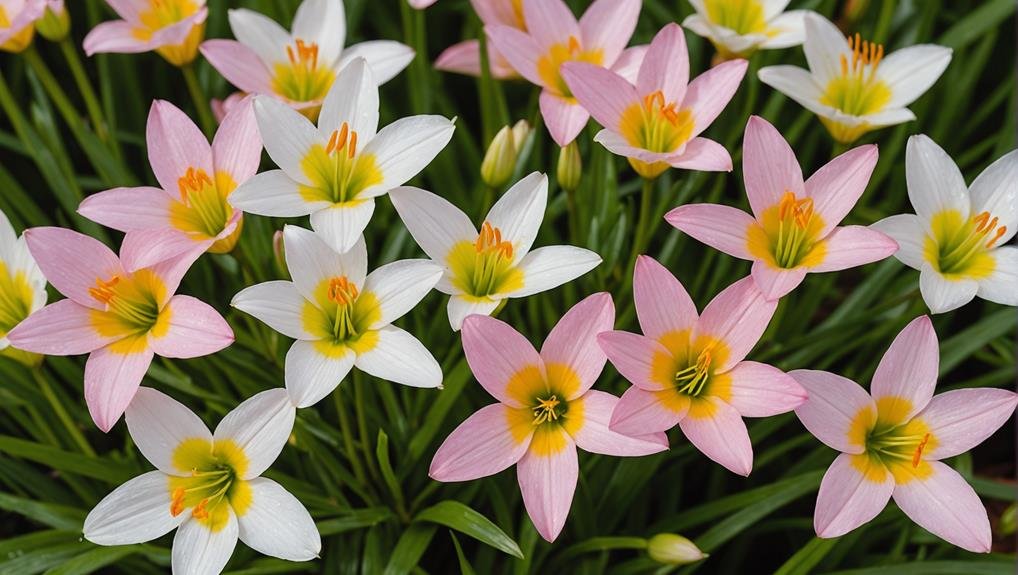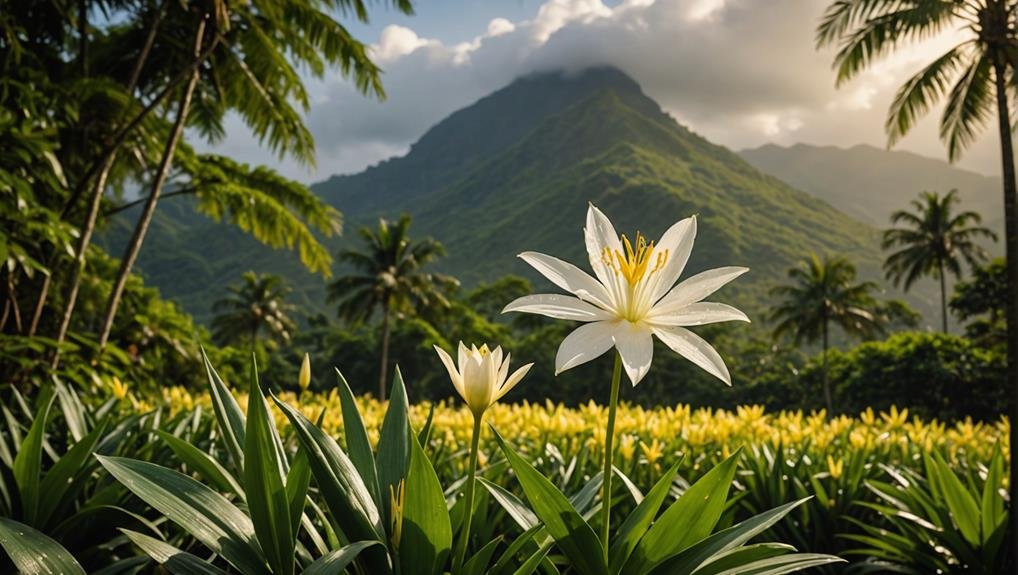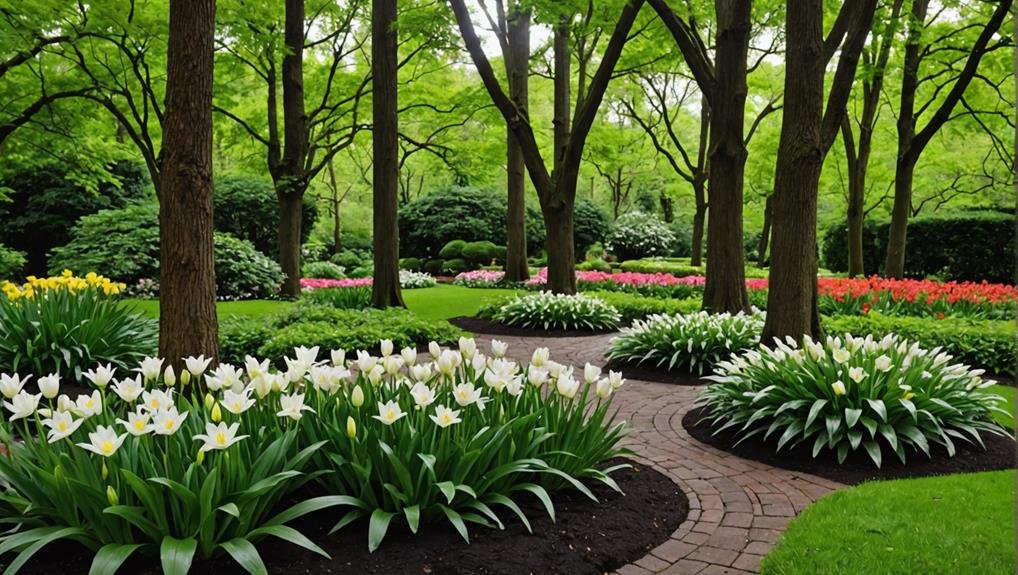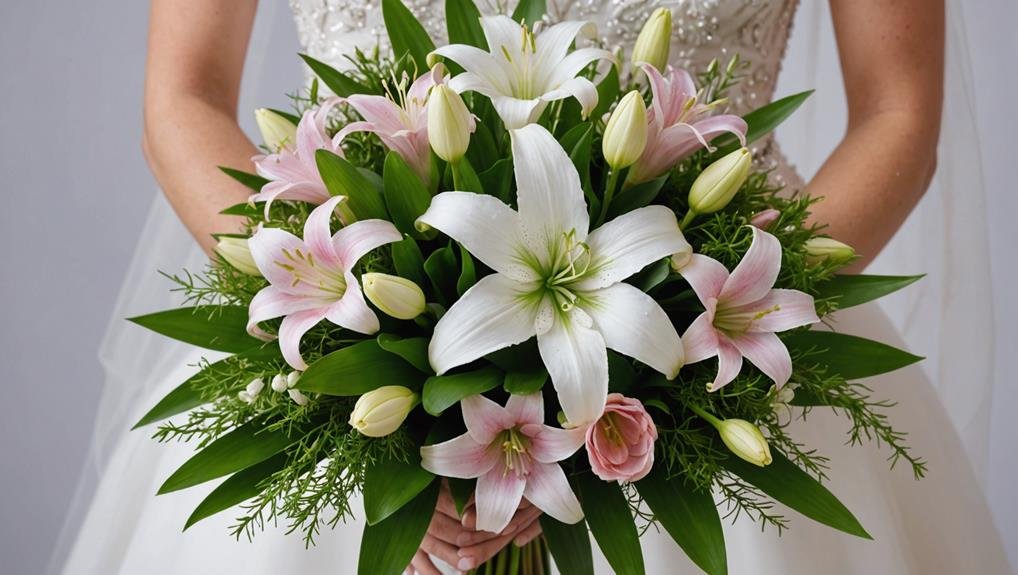Renowned for their elegant simplicity and vibrant hues, Zephyranthes, commonly referred to as Rain Lilies, are a stunning addition to wedding floral arrangements. These bulbous perennial plants feature delicate, crocus-like blossoms in shades of pink, yellow, white, and rose, symbolizing purity, renewal, and new beginnings. Their low-maintenance nature, coupled with significant cultural symbolism, makes them an ideal choice for bridal bouquets and decor. As we explore the enchanting qualities and diverse applications of Zephyranthes in wedding settings, one cannot overlook the unique charm they bring to any celebration.
Flower Overview

Zephyranthes, commonly known as Rain Lilies, are bulbous perennial plants admired for their delicate, crocus-like flowers that come in various vibrant hues. These plants are celebrated for their striking blooms, which range in colors from pink and white to red, orange, and yellow, making them a versatile and eye-catching addition to any garden. Blooming in late summer and early fall, Rain Lilies create a stunning display of color just as many other plants begin to fade.
Rain Lilies' bulbs are particularly remarkable for their ability to thrive with minimal maintenance, making them an excellent choice for gardeners of all skill levels. The bulbs are typically planted in well-drained soil and can be left undisturbed for several years, where they will multiply and produce even more flowers over time. This low-maintenance nature makes them ideal not only for gardens but also for use in wedding flower arrangements, where a touch of elegance and a pop of color are highly desired.
Varieties such as Zephyranthes grandiflora and Zephyranthes rosea offer unique flower forms and colors, further enhancing their appeal. With their vibrant summer blooms, Rain Lilies provide both beauty and practicality.
Physical Description
Characterized by their striking, trumpet-shaped blooms, Rain Lilies exhibit a range of vibrant colors including pink, white, red, orange, and yellow. These charming flowers, scientifically known as Zephyranthes, are bulbous perennial plants that thrive particularly well during the summer months. Among the various species, Zephyranthes candida stands out with its pristine white flowers. This particular species is highly favored for its elegant simplicity and is often incorporated into wedding bouquets and arrangements.
Rain Lilies typically bloom in response to late-season rainfall, adding a whimsical touch to any floral display. Each flower possesses six-pointed petals that open gracefully to face the sun, creating a visually enchanting effect. Given their delicate and solitary nature, these flowers exude an aura of purity and new beginnings, making them a symbolic choice for wedding ceremonies.
- Six-pointed petals: Creating a star-like appearance.
- Solitary blooms: Each stem supports a single flower.
- Sun-facing orientation: Enhancing their natural beauty.
- Bulbous roots: Ensuring perennial growth and resilience.
- Elegant white flowers: Particularly in Zephyranthes candida, perfect for wedding themes.
Zephyranthes, with their vibrant and varied hues, offer a versatile option for adding natural beauty and charm to wedding floral arrangements.
Available Colour Varieties

Rain Lilies present a diverse palette of color varieties, each contributing uniquely to the aesthetic of wedding floral arrangements. These enchanting flowers, known scientifically as Zephyranthes, are available in several shades, making them a versatile choice for enhancing the visual appeal of any wedding decor.
The Pink Rain Lily is especially popular, featuring small pink flowers with a green base. These blooms often herald the monsoon season, adding a touch of natural beauty to any setting. The Yellow Rain Lily (Zephyranthes citrina) displays bright lemon yellow flowers complemented by slender, light green leaves. Its vibrant hue is perfect for adding a splash of sunshine to wedding bouquets and centerpieces. The White Rain Lily (Zephyranthes candida), on the other hand, is known for its extended blooming period and produces distinctive black flat teardrop-shaped seeds, making it a timeless choice for elegant floral arrangements. Additionally, the Zephyranthes rosea, or Rose Rain Lily, showcases broad sugar-pink flowers with bright yellow stamens and a white throat, adding a delicate and charming touch to any wedding decor.
| Color Variety | Description |
|---|---|
| Pink Rain Lily | Small pink flowers with a green base, heralds monsoon season |
| Yellow Rain Lily | Bright lemon yellow flowers with slender, light green leaves |
| White Rain Lily | Extended blooming period, produces black flat teardrop-shaped seeds |
| Rose Rain Lily | Broad sugar-pink flowers with bright yellow stamens and a white throat |
These color varieties of Zephyranthes (Rain Lily) offer diverse and exquisite options for wedding floral arrangements.
Latin Name and Taxonomy
The genus Zephyranthes, part of the Amaryllidaceae family, encompasses a variety of flowering plants commonly known as Rain Lilies. This genus, belonging to the Amaryllis family, is celebrated for its striking blooms and ease of cultivation. The Latin name Zephyranthes derives from 'Zephyrus,' the Greek god of the west wind, reflecting the plant's responsiveness to rain, as Rain Lilies bloom shortly after rainfall events.
Rain Lilies are characterized by their solitary, six-pointed petal flowers, which come in a spectrum of vivid colors. These plants, native to southern North America and other parts of the Americas, thrive in tropical and subtropical regions. Here are some key features to help visualize these enchanting flowers:
- Petals: Six-pointed and symmetrical, creating a star-like appearance.
- Colors: Available in shades of pink, white, red, orange, and yellow.
- Blooms: Typically emerge in late summer to early fall, in response to rain.
- Leaves: Linear and grass-like, complementing the delicate flowers.
- Flowers: Solitary blooms on slender stems, making them ideal for elegant arrangements.
Understanding the taxonomy and characteristics of Zephyranthes is essential for appreciating their role in wedding floral designs and gardening.
Geographical Origins

Rooted in the warm climates of the Americas, Zephyranthes species flourish in regions ranging from North to South America, showcasing their adaptability and beauty. These charming bulbous plants are particularly prevalent in Central and South America, where the tropical and subtropical conditions provide an ideal environment for their growth. The warm climates of these regions, characterized by mild winters and hot summers, create perfect conditions for Zephyranthes to thrive.
Zephyranthes, commonly known as Rain Lilies, have adapted remarkably well to a variety of soil types, further contributing to their widespread presence. Their preference for full sun or partial shade allows them to flourish in diverse settings, from open fields to partially shaded gardens. This adaptability has not only cemented their place in their native habitats but also facilitated their naturalization in various regions worldwide.
The ability of Rain Lilies to prosper in warm climates makes them a favored choice for gardeners and landscapers seeking resilient and attractive floral options. Their geographical origins in Central and South America underpin their robust nature and ease of cultivation, making Zephyranthes a delightful addition to any floral arrangement, including wedding bouquets.
Season Availability
Typically available from late spring to early summer, Zephyranthes, or Rain Lilies, are an ideal choice for couples planning summer weddings. These delicate flowers, which bloom in response to rainfall, bring a touch of natural beauty to wedding bouquets and arrangements. Known for their brief but stunning flowering period, Rain Lilies offer a unique and ephemeral charm that enhances any wedding decor.
Rain Lily bulbs should be planted in the late summer to make sure they are ready for their blooming season. As these flowers are native to southern North America, their availability may vary depending on local climate and growing conditions. It is advisable to consult with florists or growers in your area to verify their availability for your wedding date.
Consider the following to imagine their seasonal appeal:
- Delicate petals shimmering with morning dew
- Soft pastel shades that complement any color scheme
- Clusters of blooms that create a lush, natural bouquet
- Graceful stems adding height and elegance to arrangements
- A symbol of renewal and new beginnings, perfect for weddings
Growing Conditions

Understanding the ideal growing conditions for Zephyranthes is key to ensuring their successful cultivation and vibrant blooms for your wedding arrangements. Zephyranthes, commonly known as Rain Lilies, thrive in USDA Zones 7-10. These plants prefer well-drained soil enriched with humus, which provides the necessary nutrients and structure for best growth. They flourish best when planted in areas receiving full sun to part shade, accommodating a variety of garden settings.
Rain Lilies typically grow to a modest height of 6-8 inches, making them ideal for creating low-profile, yet striking, floral displays. Their clumping habit ensures that they spread gradually, forming dense clusters of blooms that enhance any garden or floral arrangement.
When planting, it is important to space the bulbs 2-4 inches apart and to plant them at a depth of 2-3 times the bulb's height. Covering the planting area with a layer of mulch can help protect the bulbs and maintain soil moisture.
Rain Lilies are relatively low-maintenance and resilient, although they may be susceptible to snails and slugs. With minimal care, these charming flowers can quickly become a reliable and beautiful addition to your wedding décor.
Cultural Significance
Zephyranthes, commonly known as Rain Lilies, carry deep cultural significance, symbolizing beauty, purity, and renewal across various traditions. Their delicate blooms and ephemeral nature have made them a cherished flower in many cultures, often associated with prosperity, good luck, and new beginnings. These qualities align seamlessly with the themes of weddings, where they are frequently incorporated to enhance the symbolic depth of the celebration.
In weddings, Rain Lilies are particularly valued for their ability to convey the fleeting yet precious moments of love and commitment. Their presence in floral arrangements adds a layer of elegance and meaning, resonating with the emotions of the day. The use of Zephyranthes can infuse a sense of freshness and natural beauty into the wedding decor, enhancing the overall ambiance and aesthetic of the event.
Here are a few visual elements to illustrate their impact:
- Delicate petals: Symbolize the fragility and beauty of life's special moments.
- Pure white blooms: Represent purity and new beginnings.
- Elegant floral arrangements: Enhance the sophistication of wedding decor.
- Natural freshness: Adds an element of organic beauty.
- Ephemeral nature: Reflects the transient yet meaningful moments of a wedding.
Rain Lilies, with their rich cultural significance and symbolic resonance, are truly a fitting choice for weddings.
Typical Use in Weddings

Incorporating Zephyranthes into wedding decor allows for a delicate and elegant touch that enhances the overall aesthetic and ambiance of the event. These star-shaped flowers, symbolizing purity and renewal, are a popular choice for various wedding elements. Their versatility makes them suitable for different themes, from rustic to romantic, thanks to their soft pastel hues.
Rain Lilies are often used in bridal bouquets, centerpieces, and floral arrangements. Their petite size and graceful appearance add a whimsical and charming element to the decor. The subtle fragrance of Zephyranthes further enhances the ambiance, creating a serene and enchanting atmosphere for both the ceremony and reception.
| Element | Description | Benefit |
|---|---|---|
| Bridal Bouquets | Incorporates delicate, star-shaped flowers | Symbolizes purity and renewal |
| Centerpieces | Adds soft pastel hues to tables | Complements various wedding themes |
| Floral Arrangements | Enhances overall decor with elegance | Provides a whimsical and charming element |
| Ceremony Decor | Subtle fragrance enhances ambiance | Creates a serene and enchanting atmosphere |
| Reception Decor | Versatile blooms suitable for all themes | Adds a fresh and elegant touch |
Alternative Flower Types
For couples seeking alternatives to Zephyranthes for their wedding florals, a wide range of other exquisite flower types can be considered to achieve a similarly enchanting effect. These alternatives not only bring a unique aesthetic to wedding arrangements but also cater to different seasonal availabilities and personal preferences.
- Lilies: Known for their elegance and variety, lilies can add a classic and sophisticated touch to wedding bouquets and centerpieces.
- Orchids: These exotic blooms offer an air of luxury and are perfect for modern or tropical-themed weddings.
- Calla Lilies: With their sleek, trumpet-shaped flowers, calla lilies provide a minimalistic yet striking appearance, ideal for contemporary wedding designs.
- Ranunculus: These flowers are prized for their delicate, multi-layered petals, bringing a romantic and whimsical feel to any arrangement.
- Sunflowers: Bright and cheerful, sunflowers can add a rustic and vibrant element, perfect for outdoor or country-themed weddings.
In addition to these options, flowers like roses, peonies, dahlias, and hydrangeas can also serve as beautiful substitutes for Zephyranthes. Each of these alternatives offers unique characteristics that can be tailored to match the wedding's theme and the couple's personal style, ensuring a memorable and visually stunning celebration.
